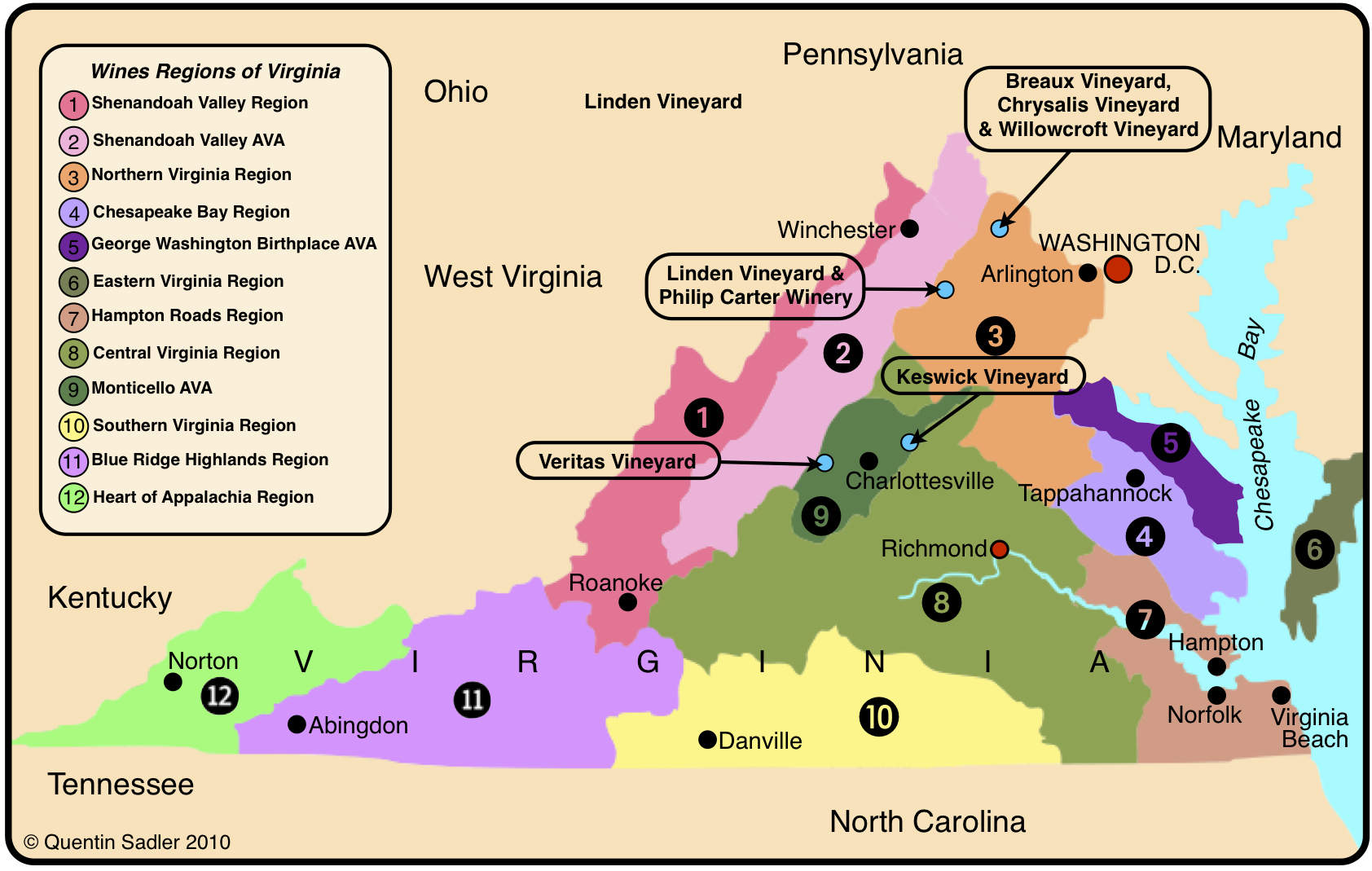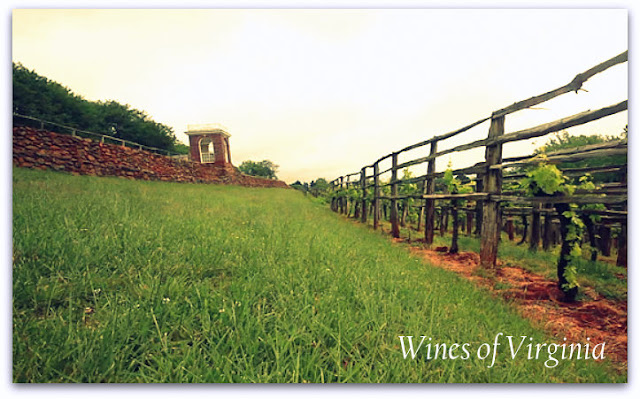Virginia Wine: Pioneering American Winemaking
"We could in the United States make as great a variety of wines as are made in Europe, not exactly of the same kinds, but doubtless as good." -Thomas Jefferson
Some may argue that Thomas Jefferson carried the torch as the first pioneer of winemaking in America. Though this Virginian certainly advocated strongly for the cultivation of vines in the New World, and he was truly an ambassador of the art of American wine, the Commonwealth where he lived actually has a history of winemaking that dates back to the very beginnings of colonization in Jamestown.
Virginia can claim over 400 years of rich winemaking history, riddled with failures, but ultimately the region finds success as a primary wine-producing state in the Eastern United States. Despite setbacks and failures, Virginian winemakers have maintained their pioneering mindset when it comes to making wine, which has allowed the industry to thrive through experimentations and innovations and challenge trade colleagues on the West Coast with a product that arguably expresses some of the best qualities of both the New and Old World.
Virginia can claim over 400 years of rich winemaking history, riddled with failures, but ultimately the region finds success as a primary wine-producing state in the Eastern United States. Despite setbacks and failures, Virginian winemakers have maintained their pioneering mindset when it comes to making wine, which has allowed the industry to thrive through experimentations and innovations and challenge trade colleagues on the West Coast with a product that arguably expresses some of the best qualities of both the New and Old World.
Jamestown and the Beginnings of Winemaking

Eager to make wine, the colonists quickly discovered that these vines were very different than the ones that went into the production of the fine wines coming out of France; wines that the English were happy to replace with products of their own. Unfortunately, the big, juicy grapes of their new native vines made for a poor-quality wine, and early settlers were forced to pivot their strategy.
Vitis Vinifera vines were brought in from Europe to boost the struggling trade of the New World. It was necessary that the colonists begin producing viable crops for export and survival, and the native grapes just would not do. Politicians got involved, and the House of Burgesses passed Act 12, which required every male household to plant ten vines of vinifera in order to jumpstart the burgeoning colonial wine industry.
Many of those original vines were planted on the land that is now home to the Williamsburg Winery in what many may call the first attempt at commercial winemaking in America. Unfortunately, the attempts at growing European vines in American soil were unsuccessful.
Many of those original vines were planted on the land that is now home to the Williamsburg Winery in what many may call the first attempt at commercial winemaking in America. Unfortunately, the attempts at growing European vines in American soil were unsuccessful.
All the vines eventually died due to the pesky root louse, phylloxera, which the European roots, unlike the native American variety, were not immune to. The colonists ultimately failed at maintaining healthy vines, which eventually forced them to experiment with alternative crops and led to the discovery of Tobacco, the new cash crop of the New World. The mandatory vine growing requirements of the time were discontinued.
Thomas Jefferson to the Rescue?
Thomas Jefferson, our third President and proud Virginian, was a passionate wine lover. In modern times, we’d probably call him a “wine-o.” He was a connoisseur of all the best labels France had to offer, and he was determined to make his own American wine on his property in central Virginia prior to his presidency. Jefferson invested over 30 years of time and money into making wine in Virginia, and was also unsuccessful in the end, despite bringing in European experts to study and cultivate the land.
Though there was some argument as to whether it was the American Revolution or phylloxera that ultimately destroyed his attempts at a wine industry, the fact remained; Virginians were struggling to make wine. Even though Jefferson’s attempts at making quality wine during his lifetime were futile, he was still a huge asset to the industry in his home state. As the most prolific high-profile wine drinker in the new Commonwealth of Virginia, Jefferson can arguably be called the original ambassador of the American wine industry.
Though there was some argument as to whether it was the American Revolution or phylloxera that ultimately destroyed his attempts at a wine industry, the fact remained; Virginians were struggling to make wine. Even though Jefferson’s attempts at making quality wine during his lifetime were futile, he was still a huge asset to the industry in his home state. As the most prolific high-profile wine drinker in the new Commonwealth of Virginia, Jefferson can arguably be called the original ambassador of the American wine industry.
Grafting and the Boom of an Industry
Something had to be done in order to produce quality wine in America with the vitis vinifera vines (the wine bearing grape) from Europe. Unlike the native American vines, it was clear that the European vine roots were not suited to American soil, as each time they were planted, phylloxera would destroy the crops. It was not until the late 1800s that the grafting of vinifera vines to native American rootstocks was discovered, and winemaking had a chance at long-term viability in the U.S.
Modern Virginia Winemaking
Between the late 1800s, when vinifera vines became viable in American soil, and the 1970s, winemaking in general in the U.S. suffered several more setbacks. Amid two World Wars, the Great Depression, and Prohibition, Virginia winemaking struggled to get off the ground until about the 1970s. Throughout this decade, wineries began to emerge throughout the state, with six becoming staples by the end of the ten-year span. The original six Virginia wineries include:
2. Piedmont Vineyards, established in 1973
3. Mountain Cove Vineyards, established in 1976
4. Shenandoah Vineyards, established in 1976
5. Barboursville Vineyards, established in 1976
6. Meredyth Vineyards, established in 1976
Finally, the efforts started by the colonists, advocated by Jefferson, and set in motion by many others along the way were finding success. Virginia had a wine industry, and it only expanded from there. Through much trial and error for the next few decades, Virginia winemakers experimented their way into producing the quality wine you see on store shelves and in restaurants today.
The determination of the winemaker in Virginia is not something only discussed in history books, but each modern winemaker in the state today must also maintain a strong drive to overcome the obstacles presented by the microclimates and weather conditions in the state on a regular basis. Those who choose to make wine in Virginia must not be averse to risk, and many are doing so because they thrive in an experimental environment.
The determination of the winemaker in Virginia is not something only discussed in history books, but each modern winemaker in the state today must also maintain a strong drive to overcome the obstacles presented by the microclimates and weather conditions in the state on a regular basis. Those who choose to make wine in Virginia must not be averse to risk, and many are doing so because they thrive in an experimental environment.
What makes wine from Virginia exciting is that there is a sense of that pioneering spirit in each bottle. There's an essence of adventure in Virginia; a unique quality of willpower and determination that permeates the region and is delivered to consumers through the expression of the land in the wine.
Virginia is a tough region, one that has seen ups and downs and trials and errors throughout 400 years of winemaking history, and yet there are 270+ wineries across the state today that are testaments to the resolve of the Virginian spirit. Hundreds of years of experimentation and that industry have emerged intact; now, that’s a true winemaking success story worthy of additional exploration.
Virginia is a tough region, one that has seen ups and downs and trials and errors throughout 400 years of winemaking history, and yet there are 270+ wineries across the state today that are testaments to the resolve of the Virginian spirit. Hundreds of years of experimentation and that industry have emerged intact; now, that’s a true winemaking success story worthy of additional exploration.
Stay tuned for more profiles and articles detailing the stories of vines, wines, and the pioneers of Virginia winemaking. Please follow the newest Cuvée Corner Contributor Jacqueline Coleman on Twitter @HistoryandWine







Comments